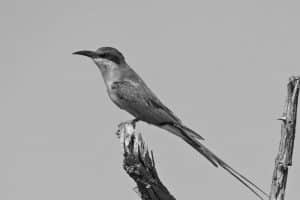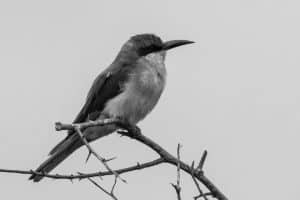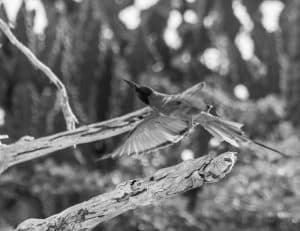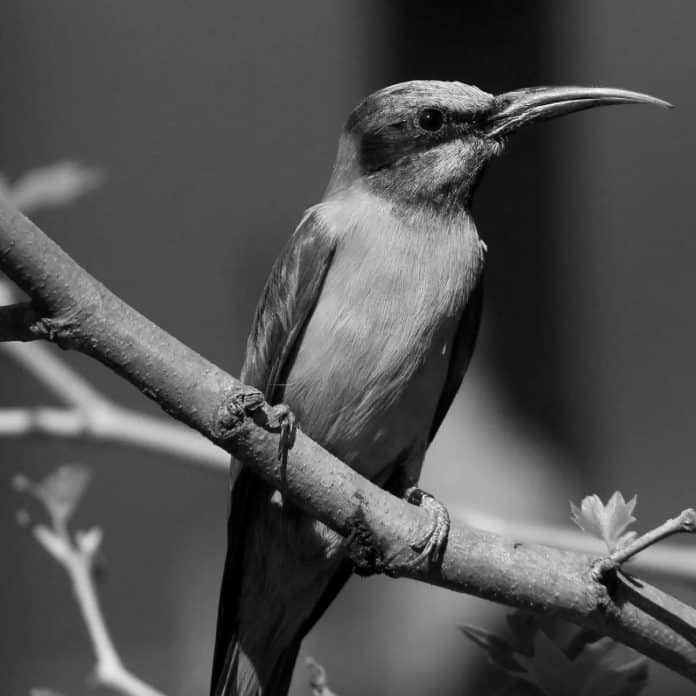Introduction to the Southern Carmine Bee-Eater
Welcome to the vibrant world of the Southern Carmine Bee-Eater (Merops nubicoides), a stunning bird species that graces the rivers of Tanzania with its vivid colors and graceful flight. With its striking carmine plumage and aerial acrobatics, the Southern Carmine Bee-Eater in Tanzania is a sight to behold for birdwatchers and nature enthusiasts alike. Found along the riverbanks of Tanzania, these magnificent birds play a vital role in the region’s ecosystems and cultural heritage.

The Southern Carmine Bee-Eater is a medium-sized bird, known for its long, pointed wings and distinctive carmine red plumage that adorns its head, breast, and underparts. In flight, their crimson hues create a mesmerizing spectacle against the backdrop of the Tanzanian rivers. Their elongated, slender bodies and slightly curved beaks are perfectly adapted for their aerial lifestyle, as they swoop and dart through the air in pursuit of their insect prey.
Habitat and Distribution of the Southern Carmine Bee-Eater in Tanzania
In Tanzania, the Southern Carmine Bee-Eaters can be found in the lush and verdant habitats along the country’s rivers, particularly the Rufiji, Wami, and Ruaha rivers. These waterways provide the perfect environment for the bee-eaters, offering an abundant supply of their preferred food source – flying insects. The riverbanks, with their sandy cliffs and exposed banks, provide ideal nesting sites for these birds, allowing them to excavate burrows for their breeding colonies.
The distribution of Southern Carmine Bee-Eaters in Tanzania is largely influenced by the availability of suitable nesting sites and the abundance of insect prey. While they are primarily found along the riverine areas, their range extends across various regions in Tanzania, reflecting the diverse landscapes that support their way of life. From the coastal plains to the inland savannas, these birds have carved out their niche in the rich tapestry of Tanzania’s natural habitats.
Behavior and Breeding Habits of the Southern Carmine Bee-Eater
The behavior of Southern Carmine Bee-Eaters is characterized by their remarkable agility in flight and their communal nesting habits. During the breeding season, which typically occurs from September to November, these birds gather in large, bustling colonies along the riverbanks. The air is alive with their calls and the sight of dozens of bee-eaters darting to and from their burrows.
Within these colonies, the bee-eaters engage in intricate courtship displays, with the males showcasing their aerial prowess to attract potential mates. Once paired, the female bee-eaters excavate burrows in the sandy banks, where they lay their eggs and rear their young. The communal nature of their nesting sites creates a vibrant and bustling atmosphere, as the colonies resonate with the sounds of chirping chicks and the constant comings and goings of the adult bee-eaters.
The Role of Southern Carmine Bee-Eaters in Tanzanian Ecosystems
The Southern Carmine Bee-Eaters play a crucial role in the ecosystems of Tanzania, particularly in the regulation of insect populations. As voracious insectivores, these birds help control the numbers of flying insects, including bees, wasps, and dragonflies, which are abundant in the riparian habitats along the rivers. By keeping insect populations in check, the bee-eaters contribute to the overall balance of the ecosystem, ensuring that the delicate web of interactions between species remains intact.
Furthermore, the nesting activities of Southern Carmine Bee-Eaters contribute to the physical landscape of the riverbanks, as their burrowing behavior helps shape the topography of these areas. The presence of their nesting colonies also attracts other species, creating a dynamic and interconnected community of wildlife along the riverine habitats. In this way, the bee-eaters are not only consumers of insect prey but also architects of the landscape and facilitators of biodiversity in their ecosystems.
Conservation Efforts for the Southern Carmine Bee-Eater in Tanzania

As with many species, the Southern Carmine Bee-Eater faces various threats to its survival, including habitat degradation, human disturbance, and climate change. Recognizing the importance of these birds in Tanzania’s natural heritage, conservation efforts have been initiated to safeguard their populations and the habitats they depend on. These efforts encompass a range of strategies, from habitat protection and restoration to community engagement and education.
One of the key conservation initiatives for the Southern Carmine Bee-Eater involves the identification and protection of critical nesting sites along the rivers of Tanzania. By designating these areas as protected zones, authorities and conservation organizations aim to minimize disturbances to the nesting colonies during the breeding season, allowing the bee-eaters to raise their young undisturbed. Additionally, community-based conservation programs work to raise awareness about the importance of these birds and promote sustainable practices that benefit both wildlife and local livelihoods.
Best Locations for Birdwatching and Photography of Southern Carmine Bee-Eaters in Tanzania
For birdwatchers and wildlife photographers seeking to witness the splendor of Southern Carmine Bee-Eaters in Tanzania, several prime locations offer unparalleled opportunities to observe these birds in their natural habitat. The Rufiji River, with its meandering course through the Selous Game Reserve, provides a captivating backdrop for birdwatching, as the bee-eaters dart and soar above the water, creating a mesmerizing display of color and movement.
In the Wami River basin, the combination of riverine forests and open grasslands provides a diverse landscape that supports a rich array of wildlife, including the Southern Carmine Bee-Eaters. Here, visitors can witness the dynamic interactions of these birds as they forage for insects and engage in their breeding rituals, all within the picturesque setting of the Tanzanian wilderness. Additionally, the Ruaha River, flowing through the Ruaha National Park, offers a stunning setting for observing the bee-eaters against the backdrop of towering baobab trees and rugged landscapes.
Tips for Observing Southern Carmine Bee-Eaters in the Wild
When venturing into the natural habitats of Tanzania to observe the Southern Carmine Bee-Eaters, there are several tips that can enhance your experience and increase the likelihood of encountering these magnificent birds. Firstly, it is essential to be patient and attentive, as the bee-eaters’ aerial antics can be unpredictable, requiring keen observation and a watchful eye to track their movements.
Additionally, utilizing binoculars or a telephoto lens can bring you closer to the action, allowing for detailed views of the bee-eaters in flight and during their nesting activities. Understanding the behavior and vocalizations of the bee-eaters can also aid in locating their nesting colonies and identifying their presence in the vicinity. Lastly, respecting the natural environment and minimizing disturbances to the wildlife is paramount, ensuring that the Southern Carmine Bee-Eaters can thrive undisturbed in their riverside habitats.
The Cultural Significance of Southern Carmine Bee-Eaters in Tanzania
Beyond their ecological importance, Southern Carmine Bee-Eaters hold cultural significance in Tanzania, where they are revered for their beauty and symbolic associations. In many local traditions and folklore, these birds are celebrated for their vibrant plumage and graceful flight, often serving as symbols of vitality, grace, and the natural abundance of the riverine landscapes.
The presence of Southern Carmine Bee-Eaters in Tanzanian culture is also reflected in the arts and crafts of the region, where their striking colors and elegant form inspire traditional designs and motifs. From ornamental carvings to fabric patterns, the influence of these birds can be seen in the creative expressions of local artisans, showcasing the enduring impact of the bee-eaters on the cultural tapestry of Tanzania.
Threats to the Southern Carmine Bee-Eater Population in Tanzania

Despite their cultural and ecological significance, the Southern Carmine Bee-Eaters face a range of threats that jeopardize their populations in Tanzania. Habitat loss and degradation due to human activities, including agriculture, infrastructure development, and logging, pose significant challenges to the bee-eaters’ nesting sites and foraging grounds. The alteration of riverine ecosystems, through dam construction and water extraction, further exacerbates the pressures on these birds and the delicate balance of their habitats.
Human disturbance, such as unregulated tourism and recreational activities near nesting sites, can disrupt the breeding colonies and cause stress to the bee-eaters, impacting their reproductive success and overall well-being. Climate change also poses a threat, as alterations in weather patterns and environmental conditions can affect the availability of insect prey and the suitability of nesting sites for the bee-eaters.
Conclusion
In conclusion, the Southern Carmine Bee-Eaters bring a touch of splendor to the rivers of Tanzania, enriching the natural landscapes with their vibrant colors and vital ecological role. As guardians of the riparian ecosystems and cultural icons of the region, these birds captivate the hearts and minds of all who encounter them. Through conservation efforts, responsible tourism, and a deeper understanding of their significance, we can ensure that the Southern Carmine Bee-Eaters continue to grace the Tanzanian rivers for generations to come. So, pack your binoculars and camera, and embark on a journey to witness the Southern Splendor of these magnificent birds along the Tanzanian rivers!

































